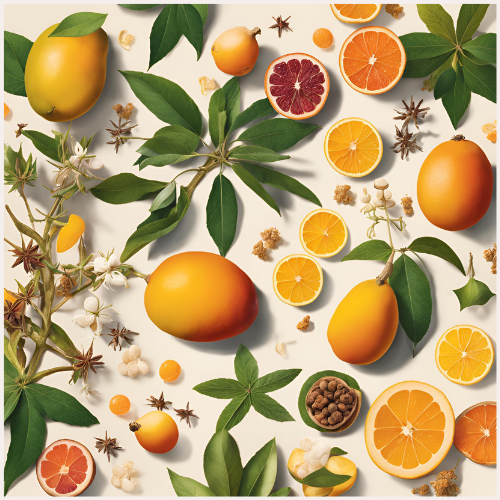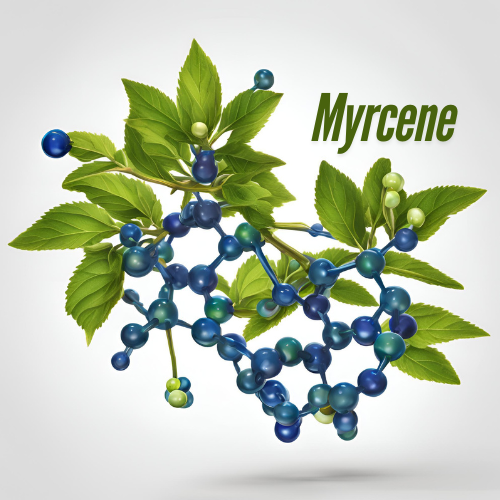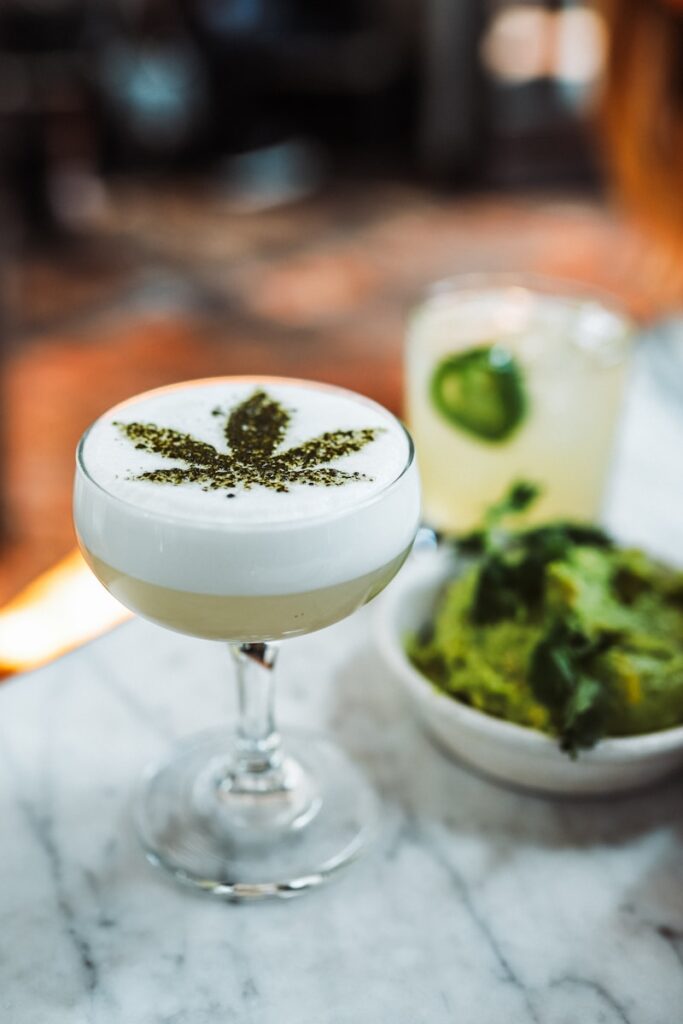
When I first started exploring Myrcene in cannabis, I had no idea how much terpenes could shape the overall experience, effects, and benefits. My journey with the myrcene terpene began when I noticed that certain strains helped me relax more deeply than others. After some research, I discovered that myrcene was a key player in those calming effects. Over time, I’ve come to appreciate how this terpene enhances not just the physical benefits, but also the overall aroma and flavor of my favorite strains. In this post, I’ll take you through my experience with myrcene and why it’s become a cornerstone of my cannabis routine.
My personal experience with myrcene has been nothing short of remarkable. As someone who enjoys exploring the unique benefits of different cannabis strains, I quickly noticed that strains high in myrcene offered a distinct sense of calm and relaxation. Whether it’s winding down after a busy day or easing muscle tension after a round of yoga, myrcene-rich strains consistently provide me with soothing relief. In this post, I’ll share my firsthand insights on the benefits of myrcene, how it enhances my cannabis experience, and why it’s become one of my favorite terpenes.

Myrcene is one of the most common terpenes found in nature, known for its earthy, musky aroma with hints of spice and herbs. It’s present in many everyday plants and foods, such as mangoes, thyme, lemongrass, and hops—giving beer its characteristic peppery scent. In the cannabis world, myrcene plays a major role in influencing both the flavor and the effects of different strains. Strains high in myrcene are often known for their sedative and calming properties, making them a popular choice for evening use or relaxation. Some well-known myrcene-rich strains include Blue Dream, OG Kush, Granddaddy Purple, and Harlequin. The terpene doesn’t just affect how a strain smells; it also impacts the way cannabinoids interact with your body, potentially enhancing THC absorption and promoting relaxation. In the next section, I’ll dive deeper into how myrcene works, its potential health benefits, and how it can shape your overall cannabis experience.
Myrcene is widely found throughout nature, appearing in a variety of plants, fruits, and herbs. Mangoes are one of the most well-known sources, which is why they’re often linked to enhancing the effects of cannabis. Herbs like thyme, basil, and parsley are also rich in myrcene, contributing to their distinct earthy and herbal aromas. You’ll find it in hops too, where it helps create the characteristic flavor and scent of many beers, especially in hoppy ales. Even lemongrass, commonly used in teas and traditional remedies, contains a significant amount of myrcene. What’s fascinating is that myrcene not only adds flavor and fragrance but also offers potential therapeutic benefits, such as anti-inflammatory and sedative effects. In the upcoming section, I’ll explore how these natural sources contribute to the terpene’s role in cannabis and beyond.
The aroma profile of myrcene is one of the most distinctive among terpenes, characterized by its earthy, musky scent with subtle hints of spice and herbal undertones. This rich, grounding fragrance is part of what gives many cannabis strains their signature “dank” smell. Beyond cannabis, myrcene contributes to the aromatic profiles of various plants like thyme, lemongrass, and hops, where its peppery and slightly balsamic notes enhance their appeal. Interestingly, its musky scent can also be found in ripe mangoes, which may be why eating mangoes before consuming cannabis is said to intensify the experience. Myrcene’s aroma not only adds depth to cannabis strains like Granddaddy Purple, OG Kush, and Blue Dream but also plays a role in relaxing the mind and body. In the following section, I’ll delve deeper into how this unique aroma impacts both flavor and the overall cannabis experience.

Myrcene is widely known for its calming, sedative effects, making it a favorite for those seeking stress relief, better sleep, or relaxation after a long day. It’s also believed to have anti-inflammatory properties, which may help with muscle tension, pain, and even conditions like arthritis. In addition, myrcene has been shown to enhance the permeability of cell membranes, potentially allowing cannabinoids like THC and CBD to be absorbed more effectively. This synergy might explain why myrcene-rich strains, such as Granddaddy Purple and Harlequin, are so effective for both physical and mental relaxation.
The health benefits of myrcene extend far beyond its relaxing effects. Known for its potential as a natural anti-inflammatory, myrcene may help reduce pain and swelling, making it a promising option for those dealing with chronic pain or joint discomfort. It’s also believed to have mild sedative properties, which can aid in improving sleep quality and reducing anxiety. Additionally, research suggests that myrcene could act as an antioxidant, helping to protect cells from oxidative stress. Some studies even point to its antimicrobial properties, which might enhance the body’s defense against harmful bacteria and fungi. Given these potential benefits, it’s no surprise that myrcene is a sought-after terpene in both cannabis strains and herbal remedies. Below is a chart summarizing the key health benefits of myrcene:
| Health Benefit | Description |
|---|---|
| Anti-inflammatory | May reduce inflammation and pain, offering relief for conditions like arthritis. |
| Sedative | Known for its calming effects, potentially improving sleep and easing anxiety. |
| Antioxidant | Helps protect the body from oxidative damage caused by free radicals. |
| Antimicrobial | May provide mild protection against harmful bacteria and fungi. |
| Enhanced THC Absorption | Believed to increase the absorption of cannabinoids, enhancing the overall cannabis effect. |


The emotional and psychological effects of myrcene are often described as calming, grounding, and mood-enhancing. Known for its sedative properties, myrcene can help reduce stress and anxiety by promoting a sense of deep relaxation. I’ve personally found that myrcene-rich strains are perfect for unwinding after a hectic day or when I need to quiet a busy mind. Beyond relaxation, myrcene may also improve mood by indirectly influencing serotonin and dopamine levels, which are key neurotransmitters involved in emotional balance. Its ability to enhance the absorption of cannabinoids like THC can further intensify the euphoric effects of cannabis, making it a great terpene for those looking to enhance both mental and emotional well-being.
Incorporating myrcene into your daily routine can be both easy and enjoyable, especially with the variety of natural sources available. One of the simplest ways is by choosing cannabis strains known to be high in myrcene, such as Blue Dream, OG Kush, or Granddaddy Purple, which are perfect for relaxation and stress relief. You can also boost your myrcene intake through foods like mangoes, thyme, and lemongrass—try adding these ingredients to your meals or making a soothing herbal tea with fresh lemongrass and thyme. Another option is using essential oils rich in myrcene, such as basil or hops oil, for aromatherapy, which can promote a calming atmosphere. Whether through cannabis, food, or aromatherapy, finding the right way to incorporate myrcene depends on your personal preferences and wellness goals.
There are several effective consumption methods for experiencing the benefits of myrcene, each offering a unique way to enjoy its calming and therapeutic effects. Smoking or vaping cannabis strains high in myrcene is one of the quickest ways to feel its effects, as the terpene is rapidly absorbed through the lungs. For a longer-lasting experience, edibles made with myrcene-rich strains or infused oils are a great option, allowing the terpene to be metabolized more slowly by the body. You can also consume myrcene through natural foods like mangoes or herbal teas made with thyme and lemongrass, which are rich in this aromatic compound. Essential oils containing myrcene, such as hops or basil oil, can be used for topical application or in a diffuser for aromatherapy, offering a gentle, non-invasive method to absorb the terpene. Whatever method you choose, myrcene offers a versatile way to enhance both physical relaxation and emotional well-being.
Combining myrcene with other terpenes can create enhanced effects, thanks to what’s known as the entourage effect. This concept suggests that terpenes work synergistically with cannabinoids like THC and CBD to amplify their overall impact. When myrcene is paired with calming terpenes like linalool or beta-caryophyllene, the result can be an even more pronounced sense of relaxation, making it ideal for stress relief or sleep support. On the other hand, when combined with uplifting terpenes like limonene or pinene, myrcene helps create a balanced experience, offering both mental clarity and physical calm. I’ve found that experimenting with different terpene combinations allows me to fine-tune my cannabis experience based on my mood and needs, whether that’s relaxation, focus, or an overall sense of well-being.
When it comes to dosage and safety considerations for myrcene, it’s important to keep a few key factors in mind. Myrcene is generally considered safe when consumed through natural sources like cannabis, herbs, and fruits. However, like any compound, consuming excessive amounts can lead to unwanted side effects, such as drowsiness or lethargy. Since myrcene is known for its sedative properties, it’s best to start with small doses, especially if you’re new to cannabis or using myrcene-rich products for relaxation. If you’re combining myrcene with other calming terpenes or cannabinoids, be mindful of the cumulative effects, as they may increase sedation. Additionally, while myrcene from food sources is unlikely to pose any risks, those using concentrated essential oils should ensure they’re diluted properly before topical use to avoid skin irritation. As with any supplement or wellness product, moderation and listening to your body’s response are key to safely enjoying the benefits of myrcene.
Join our community of cannabis enthusiasts and terpene explorers! Get exclusive insights, in-depth guides, and the latest discoveries. No spam—just pure, aromatic knowledge delivered straight to your inbox.
Subscribe now and elevate your cannabis wisdom!